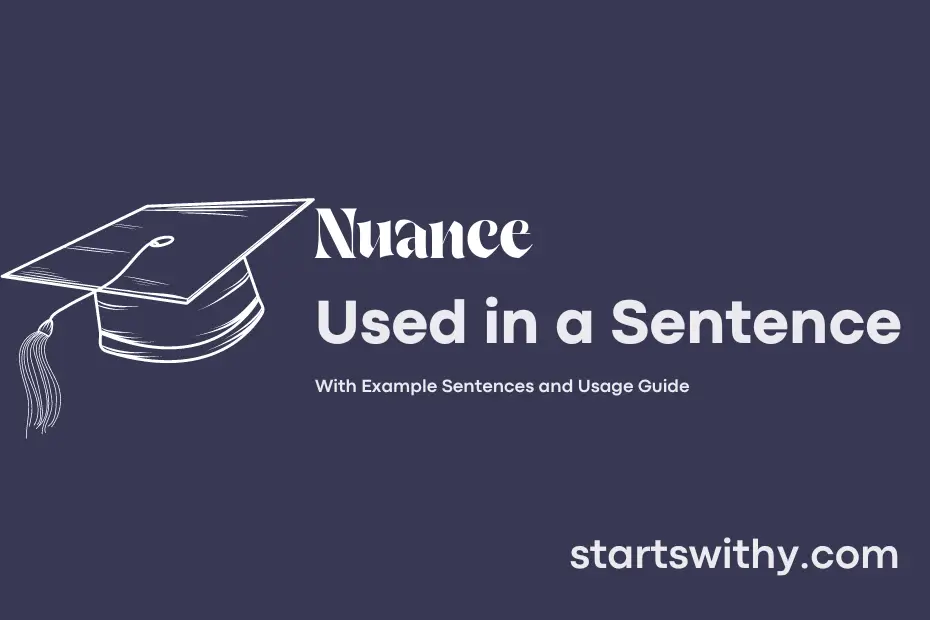Have you ever noticed subtle differences in meaning that can completely change your understanding of a message? These subtle distinctions are known as nuances, adding depth and complexity to language.
When we pay attention to nuances, we are able to grasp the subtle shades of meaning in communication. It’s these nuanced details that can make a significant difference in how we interpret spoken or written words, allowing for a more precise understanding of the message being conveyed.
7 Examples Of Nuance Used In a Sentence For Kids
- Leaves come in many nuances of green and yellow.
- The sky has different nuances of blue in the morning and evening.
- Flowers have nuances of different colors like pink, red, and blue.
- Butterflies have beautiful nuances on their wings.
- Birds sing in different nuances of chirps and tweets.
- The sea has nuances of blue and green in its waves.
- The rainbow shows nuances of all the colors in the sky.
14 Sentences with Nuance Examples
- Understanding the cultural nuances can help international students adapt better to the Indian education system.
- It’s important to pay attention to the professor’s nuances in their lectures to grasp the full meaning.
- Writing a research paper requires a deep understanding of the nuances of academic language and citation styles.
- Many students struggle with the nuances of time management, especially when balancing academics and extracurricular activities.
- In group projects, it’s essential to communicate effectively to avoid misunderstandings caused by nuances in communication styles.
- The nuances of different learning styles can impact how students absorb and retain information in the classroom.
- Recognizing the nuances in different viewpoints can lead to more thoughtful and respectful discussions in class.
- When studying literature, it’s crucial to analyze the nuances of themes and character development to fully appreciate the text.
- International students often face challenges in picking up the nuances of colloquial language and slang used on campus.
- Engaging with diverse perspectives can help students appreciate the nuances of social issues and foster a more inclusive campus community.
- Understanding the nuances of data analysis is essential for students pursuing degrees in fields like economics or psychology.
- Effective communication skills involve not just words but also the nuances of body language and tone of voice.
- Navigating the nuances of group dynamics can help students become better team players in collaborative projects.
- Recognizing the nuances of ethical decision-making can guide students in navigating complex moral dilemmas both in academia and in life.
How To Use Nuance in Sentences?
To use “Nuance” in a sentence, you should first understand that the word refers to subtle distinctions or variations in meaning, expression, tone, or color. When using “Nuance” in a sentence, you want to convey a sense of complexity or depth in your message.
Here’s an example of how to use “Nuance” in a sentence: “The author’s writing was full of nuance, as she expertly layered different emotions in her characters’ dialogue.” In this sentence, “nuance” is used to describe the intricate and subtle details in the author’s writing.
Remember, “Nuance” is a versatile word that can be applied to various contexts, such as art, literature, communication, and even everyday conversations. It adds a level of sophistication and precision to your language, allowing you to express ideas with more depth and subtlety.
When incorporating “Nuance” into your sentences, pay attention to the specific details or distinctions you want to highlight. Consider how these subtle differences enhance the overall meaning or tone of your message.
By practicing and experimenting with using “Nuance” in your sentences, you will gradually become more comfortable incorporating this word into your vocabulary. As you gain confidence, you’ll discover how “nuance” can enrich your communication and help you express yourself more effectively.
Conclusion
In writing, sentences with nuance add depth and complexity to communication by subtly conveying layers of meaning and emotions. By incorporating nuance into your sentences, you can capture the intricacies and subtleties of a situation, allowing for a more nuanced understanding and interpretation by the reader. Nuanced sentences can evoke empathy, spark curiosity, and create a richer and more engaging reading experience.
Whether it’s a subtle play on words, a clever use of irony, or a carefully crafted metaphor, sentences with nuance invite readers to pause, reflect, and dive deeper into the text. They facilitate a more profound connection between the writer and the audience, encouraging critical thinking and fostering a deeper appreciation for the beauty and complexity of language.



